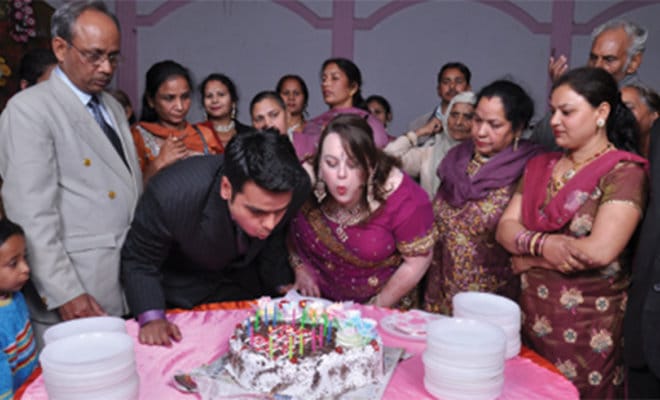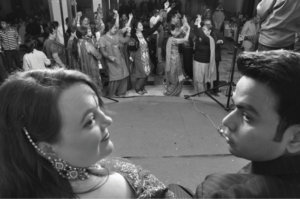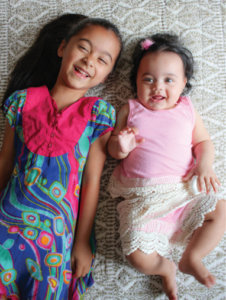Life
Videshi Brides Blogging Desi Vibes

From seeing an Indian mother-in-law feeding her grown-up son to explaining to the white relatives that cinemas and computers exist in India. These videshi bahus are blogging the experiences of their cross-cultural marriages while busting many myths.
Marlena Gandhok describes herself as a typical mom with some very relatable apprehensions. She worries about her toddler son getting ill, hitting his head on the playground, not eating enough and so on. However, the Poland born, UK-based mom admits that these aren’t her biggest fears. She is much more concerned about her son being bullied, marginalized or feeling lost about not being able to identify with a single ethnicity.
The Gandhok family belongs to a small but growing number of multicultural, multi-faith, multi-lingual families. Of Polish, European and Roman Catholic heritage herself, Marlena married Bikram, an Indian Sikh based in Britain. While life, according to her, is a rollercoaster, as together they are raising a trilingual, British kid with Polish and Indian heritage, she realizes that growing up, her son may wonder why he doesn’t fit into any typical questionnaire groups. She is constantly helping her young son develop a strong sense of his own identity and be proud of his diversity.

Marlena Gadhok, a Pole married to Bikram, a Sikh-Indian based in Britain, are raising a trilingual, British child with Polish and Indian heritage.
Gandhok says: “When I fill the registration form for my son, there is one box that brings a smile on my face — religion. It’s a small box, perfect for a few letters. But in our case, there are few more letters than usual. He is Catholic. He is Sikh. So, he is Catholic-Sikh or Sikh-Catholic, whatever you may prefer.”
Demographic shifts with immigration are resulting in rising numbers of inter-racial marriages. In an increasing vitriolic atmosphere of race, culture and different ethnicities across the globe today, it is refreshing to discover a host of multicultural brides blogging and dispelling myths and misconceptions about different cultures in their collaborative marriages.
As Asian identity becomes a subject of contentious discourse, especially in America, many white brides insist that their unions, despite the perceived differences, often seem like an extension of their own cultures.

Kristy Robinson and Rohit Kumar at their wedding ceremony.
Kristy, a Southern American criminal justice professional, met her husband Rohit from Punjab, India, online. She had her roka ceremony on her maiden trip to India and she says that the relationship progressed from there. Kristy has lived in an Indian joint family and is now based in Virginia. In a highly polarized and toxic environment for race and ethnicity in the United States, does she feel her blog serve to highlight the cultural similarities? She says, “I wouldn’t say that my marriage is a perfect example, but a lot of values and morals I was raised with, Rohit was also raised with.”
She adds: “America has always been a cultural melting pot, there is no reason why we can’t accept each other as human first and by our skin color last. Skin color is not an accurate representation of race. I know many Punjabi women who are just as fair-skinned as I am.”
For many women, documenting their stories has also been a powerful vehicle to debunk myths on both continents. Cynthia Haller was born and raised in Geneva, Switzerland, and now lives in Mumbai, with her Indian husband and their daughter. She writes frequently about her life on her blog, HomeCynHome.
She says: “I have debunked myths on both sides. My Western friends tend to still see India as a land of poverty, dirt and spiritual fix. Some members of my family even struggled with the idea that computers, cinemas, shopping malls and apartment buildings existed in the country. I remember them even picturing me living in a slum at one point! In India, I had and still sadly have to debunk myth about western women being promiscuous, divorced and unable to care for the household. Not to mention we apparently can’t cook either, because the only food eaten in the West is junk food that we make in a microwave. The food myth I had to explain to a couple of ignorant doctors too. Because when I suspected PCOS and insulin resistance, I had to pretty much force my gynecologist to investigate. She was convinced that the only reason I was overweight was because I was a foreigner and foreigners only eat junk food.”
WHITE PREJUDICE?
While common perception holds that Indian families are very conservative, interestingly many of these blogs shed light on how social prejudices are ingrained in Western families too. Tanya Moore, an Australian married to an Indian, blogs her journey under the name, The White Punjabi Bride. She says when she announced her intention to marry an Indian to peers: “The typical Indian man in Australia tends to always marry a good Indian girl, so it was expected that most people were skeptical about our relationship. Most assumed that my husband wanted to marry me to obtain residency in the country. Particularly so because I had dated a few other Indian men prior to meeting my partner and they all dumped me for a good Indian girl.”

Tanya Moore, an Australian married to an
Indian: “Most people assumed that my husband
wanted to marry me to obtain residency in the
country.” Below: Couple celebrating Holi.
According to several foreign brides, some western families can be very clanish. Cynthia Haller says that when she broke the news of dating an Indian guy all hell broke loose: “My stepmom tried hard to meddle in my love life and pushed me to go to parties to meet new guys because (dating) an Indian, thousands of miles away, was a very poor choice and the guy was probably only after my passport and citizenship.”
She adds: “When I moved to India, they all still thought it was a crazy youth experience that had to run its course. My stepmom would launch herself into emails that told me all about the nice beef stews, and fondues, and yummy cheeses they had at the last family meal. She always made sure to ‘drive the point home’ by mentioning that she was ‘sure I was missing all those things and that it was sad I could not get them in India.’ These mails infuriated me more than they made me homesick, because once again, my life choices were not respected. My sister told me that she had to explode at family gatherings frequently, because I became the favorite topic of discussion and it always went down into a racist mudslinging. As of date, 14 years after I moved to India, my paternal grandma still hasn’t really come to terms with my choice and still hopes I will move back to Switzerland.”
NORMALIZING WHITE & BROWN
The reason many of these women took to blogging about their experiences was also because they wanted to normalize the white girl married to brown guy or vice versa union. Most of them agree that they are tired of the odd stares they often get and some of them even want to bust the impression about white girls trying to find exoticism or spiritual peace in India.
Cynthia Holler says that she’s bummed when people expect her to write about “postcard India.” She insists that her blog is nothing about a firangi finding bangles, salwars, bindi or spirituality exotic. Thus, offering a refreshing outlook toward foreigners who now call India their home.
Many of these blogs show that for a Westerner it is not essential to either fall in love with the yoga inspired western view of India or to try to amalgamate into an Indian bahu avatar to be understood in India.

Alexandra Madhavan’s children: “People need to get used to the fact that families come in all shades and colors.”
Alexandra Madhavan, a Canadian married to a South Indian Iyengar, has been documenting her story of meeting a boy from Hyderabad in the small American town of Savannah, Georgia, in her blog MadhMama. She says: “Some of my biggest challenges involve dealing with the ignorance of other people. This is because most people don’t have exposure to interracial relationships. Little things like people asking if you’re together at the grocery store check-out line, or giving you separate checks at restaurants — it adds up. Or people assuming that I’m my child’s nanny. It’s irritating more than anything! People need to get used to the fact that families come in all shades and colors. It’s far better than it used to be, but nowadays there are a lot of racial micro-aggressions that people make, sometimes unknowingly. The best thing that we as cross-cultural couples can do is speak out about these uncomfortable instances so that people can begin to educate themselves and we can slowly change the tide for the next generation.”
APPRECIATING NOT ASSIMILATING
The blogs of many western women married to Indian men also show that contrary to romantic notions about marriage, not all cross-cultural marriages are about finding coherence in ideas and practices. The new-age couples have found ways to appreciate each-other’s culture without diluting their own practices. Many brides admittedly took some time to understand the reasons for difference in attitudes.
Alexandra Madhavan says: “We also had a lot of challenges in the early days of our transition to parenthood. Most couples have these issues, but ours was more because we had more culture clashes. Differences in how to feed the baby, how to put her to sleep are different in the East v. West mindset. It taught me an important lesson in our relationship — it’s okay if we have differences as parents. We don’t have to do everything the same. It comes down to respecting that we each have our own methods.”
Kristy admits that a multi-faith, multicultural marriage comes with its share of anxieties, which are best addressed, not ignored: “My biggest apprehension about getting married in India was not knowing the details of how the wedding was to play out. I was concerned, I didn’t know what the priest was saying and what I could be agreeing to. I didn’t know what to do, when to do it, if I would have to say anything during the wedding. I had never seen a full saptabadi (taking the seven steps around the fire, as in a Hindu marriage ritual) before and videos online were not a good representation.”
Marlena Gandhok says the secret to her happy intercultural marriage has been the fact that she made no major adjustments: “I maintain my own traditions, religion, eating habits and so on. I am just enriched by my husband’s religion and culture.”
MONSTER-IN-LAW?
Never mind the culture, what about that monster mother-in-law? The blogger bahus says their experiences have often been extraordinary. But given time and understanding, they have been able to resolve most issues, like in any other marriage. Often the differences have been mindboggling. Alexandra Madhavan says that when her mother in law first came to visit, she took a double-take seeing her feeding her 30-year-old son by hand.
She says: “A lot of readers idolize my relationship with my mother-in-law because we are very close, but it didn’t start out this way. It started when we landed in India in the middle of the night and I arrived on her doorstep — her son’s 20-year old foreign girlfriend! The shock on her face was priceless. It was a long journey, and even 12 years later, we are still building our relationship.”
Many of these women share heartwarming stories too. Tanya Moore was in Brisbane, Australia, when her then boyfriend had to return to India to attend to a close relative diagnosed with cancer: “I decided to take a leap of faith for love and followed him to India with the help of his parents. They bought my tickets for the next flight out to India. They took just as much risk in me as I did in my partner. Turns out it was all worth it. We decided to get married in India and had our own Big Fat Punjabi Wedding.”
Madhavan says it took her a while to understand the reservations of Indian families toward a foreign girlfriend: “Another challenge I had was to learn how to forgive extended family members who were not very nice to me in the early days of our relationship. We spent a lot of time in India before marriage when I was just a ‘girlfriend’ and many times, people didn’t treat me very nicely. That changed the moment my status was upgraded to a wife.”

2 Comments
You must be logged in to post a comment Login